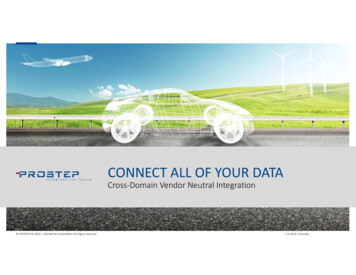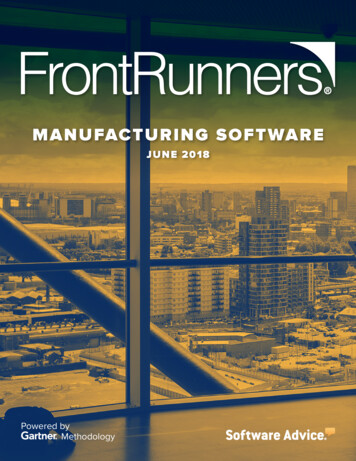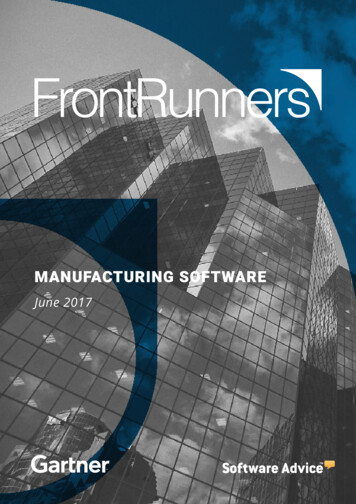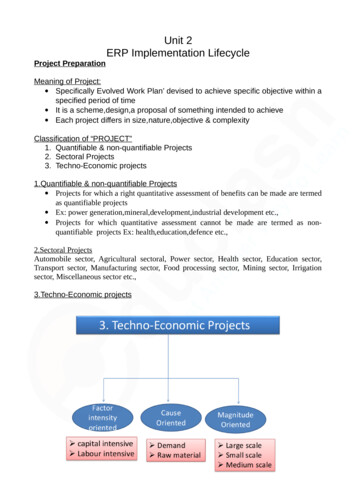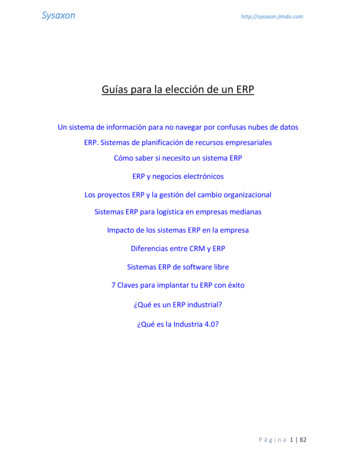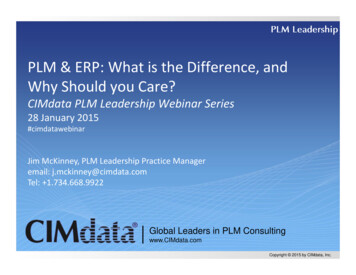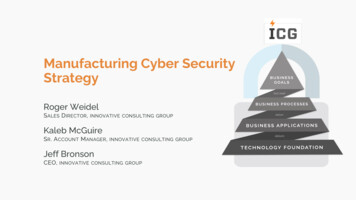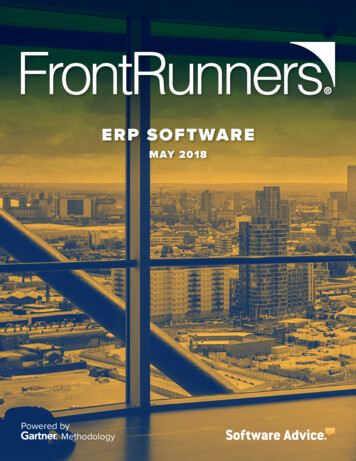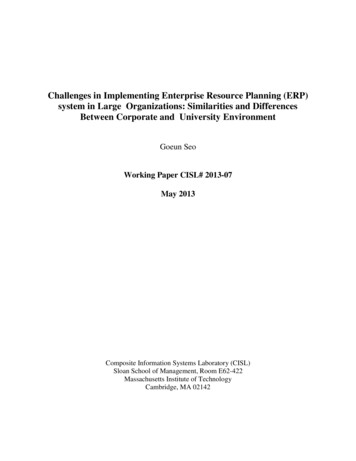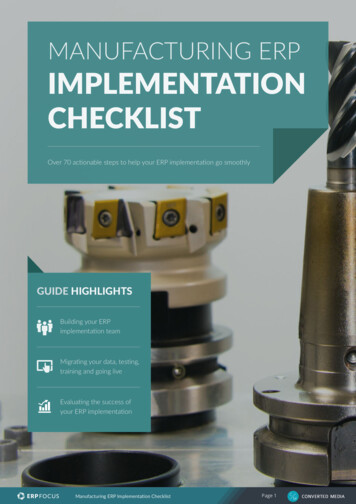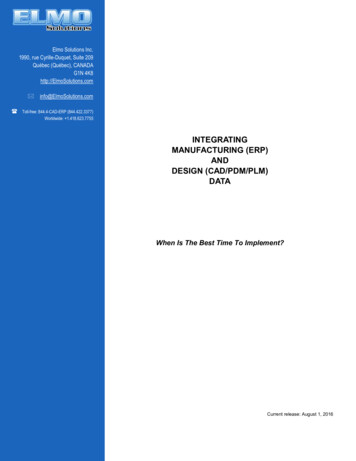
Transcription
Elmo Solutions Inc.1990, rue Cyrille-Duquet, Suite 209Québec (Québec), CANADAG1N 4K8http://ElmoSolutions.com info@ElmoSolutions.com Toll-free: 844.4-CAD-ERP (844.422.3377)Worldwide: 1.418.623.7755INTEGRATINGMANUFACTURING (ERP)ANDDESIGN (CAD/PDM/PLM)DATAWhen Is The Best Time To Implement?Current release: August 1, 2016
INTEGRATING MANUFACTURING (ERP) AND DESIGN (CAD/PDM/PLM) DATA When Is The Best Time To Implement?The ROI Challenge:Maximizing the “R”,Minimizing the “I”The ROI Challenge: Maximizing the “R” While Minimizing the “I”When selecting a new ERP solution, the best business decision is often to include an integrationsolution for Computer-Aided Design (CAD), Product Data Management (PDM) or ProductLifecycle Management (PLM) data in the ERP system.Such an investment makes a lot of sense, especially for manufacturing businesses that operatemostly in an Engineered-To-Order (ETO), Built-To-Order (BTO) and/or Made-To-Order(MTO) production environment. Taking an integrated approach (notably the less error-pronebidirectional strategy, as opposed to the low-priced but mush less reliable, export-importmethod) offers numerous benefits and savings, namely:Elimination of some costly errors on the shop floorAlthough this payback is usually the most difficult to assess ahead of time, it is also most oftenwhere the bigger portion of the ROI comes from. Many of us have heard of horror stories aboutcostly manufacturing errors arising from the use of an erroneous or out-of-date, which can belargely eliminated by using a tool that ensures consistency of BoM data throughout the transitionfrom design to manufacturing.Better yield through the optimization of materials useAllowing design changes and new orders to get to the shop floor faster translates intosignificantly reduced scrap, while dramatically shortening lead time. One manufacturer has maderecurrent savings of 250,000 on an initial investment of less than 10,000, simply by optimizingraw materials use.No more redundancy in data entryBased solely on the elimination of manual transcription from CAD to ERP, a bidirectional CADERP integration solution typically pays for itself within 60-90 days of implementation.ERP and CAD data always in syncInstantly communicating design changes from Engineering to Manufacturing usually translatesinto better collaboration between both functions of the company, as well as increased feedbackfrom both sides. Once again, although this benefit is not easy to quantify, virtually anyoneworking in any manufacturing business has heard stories where disasters—big and small—couldhave been avoided with better communication between the people who design the product, andthose who actually make it.Minimal disruption of design changes throughout the production processSeamless, bidirectional communication and synchronization between manufacturing andengineering data reduces the risk of disruption between all players involved in the manufacturingprocess. It turns the various changes to the company into smoother and more natural transitions.The Money FactorThe Financial Factor: Is CAD-ERP Data Integration Really Is aSound Investment?Figure 1 presents a typical ROI assessment, based solely on the elimination of manualtranscription of data from CAD to ERP. It is important to note that the number ofhours represents the time spent on transcription on a regular basis. During theimplementation phase, where many more brand new Bills of Materials must be createdand/or updated, the ROI can easily reach 2-3 times that level, hence the huge benefit ofimplementing CAD-ERP integration right from the start, thus increasing the ROIaccordingly.
INTEGRATING MANUFACTURING (ERP) AND DESIGN (CAD/PDM/PLM) DATA When Is The Best Time To Implement?Figure 1—Typical ROI assessment, based solely on elimination of manual BoM data transcriptionINVESTMENTSoftware purchaseFirst year maintenanceImplementation supportTotal investment 13,465 2,693 5,000 21,158COMPANY DATAHours per week spent on manualCAD-ERP BoM transcriptionAverage fully burdened hourlylabour cost (per user)Number of average work weeksper yearTotal opportunity loss due tolabor cost40 4050 80,000Total opportunity loss due to bytranscription errors in BoMsTBDTotal recurring yearly savings 140,000Approximate Payback Period3.2 Months (97 days)The Human Factor: Advancing Faster on The Learning CurveImplementing a new ERP system invariably changes the business processes, hence theworkflows, and eventually the work. This largely explains while some implementations fail,mostly due to inadequate end-user adoption. Involving all departments as early as possiblein the process ensures a much better adoption and guarantees a much more successfulimplementation.Involving the engineering department is key to adoption, as they are the prime suppliers ofmanufacturing data and, as such, they should be involved as early as the system designstage, thus having sufficient time, if needed, to make the required changes in theirworkflows, to be ready when implementation of manufacturing functionality occurs. Inother words, the implementation of engineering and manufacturing data integration shouldbe done as early as possible. This gives everyone involved sufficient time to successfullytailor their workflows for when “the gates are opened”- and engineering data flows freelybetween CAD/PLM/PDM and ERP systems.And, come to think of it: would we consider rolling out Accounts Receivable andInvoicing without integrating them? If not, why would we consider keeping ourengineering and manufacturing Bills of materials in isolated « silos »?The Human Factor
INTEGRATING MANUFACTURING (ERP) AND DESIGN (CAD/PDM/PLM) DATA When Is The Best Time To Implement?Plan ahead to avoid pitfallsThe Technical Factor: Avoiding The Pitfalls of CAD-ERPIntegration by Planning AheadSo you have made the oh! so wise decision of including CAD data integration intoyour future ERP system? Congratulations! You will be forever thankful to bothyourself and the other wise people who talked you into it. Keep in mind, however,that we are talking about the high road to integration. It needs to be a two-waystreet, which means that your ERP implementation will have to be designed, rightfrom the start, taking into account the (often new) business process of sharingengineering and ERP data. With proper consultation from the right people, itshould not be a bumpy road - but it must first be traveled at a moderate speed. Asalways, careful implementation planning, leads to a successful (and highly profitable) implementation. This requires careful planning, otherwise you may end upwith two beautiful half-bridges that will never properly connect.Bottom Line?Your Bottom Line!Long Story Short: The Sooner, The BetterThe value of the ROI associated with the integration of CAD/PDM/PLM and ERP data isperceivable on many fronts, especially over the implementation phase. During this period,the volume of new data that needs to be created in the ERP system is more significant thatwhich is produced once the initial implementation is complete.This is why the answer to « When? » is usually « ASAP ». By investing in CAD-ERPintegration early on, you will reap greater benefits, for a longer period of time, as well asthe flexibility to work with virtually any CAD, PLM or ERP product.Established in 1979, Elmo Solutions, a subsidiary of IRISCO du Québec Inc., develops and marketssoftware solutions dedicated to the creation, management and diffusion of CAD/ PLM metadata.Its flagship software product is Agni Link, an award-winning CAD to ERP integration solution thatsupplies a "hot" link through a "live" approach.For further information, you may also email the Elmo Solutions team atinfo@ElmoSolutions.com, or call our toll-free number (North America only): 1-844-4-CAD-ERP ( 1-844-422-3377). Outside of North America: 1.418.623.7755.
Elmo Solutions Inc.1990, rue Cyrille-Duquet, Suite 209Québec (Québec), CANADAG1N 4K8http://ElmoSolutions.com info@ElmoSolutions.com Toll-free: 844.4-CAD-ERP (844.422.3377)Worldwide: 1.418.623.7755This document has been created and published by Elmo Solutions Inc. Thisdocument is copyrighted property of Elmo Solutions with all rights reserved.This information may not be copied in whole or in part without the prior writtenconsent of the copyright owner.This document is for informational purposes only. The information in this document represents the view of Elmo Solutions Inc., as of the date of publicationand is subject to change.ELMO SOLUTIONS INC. MAKES NO WARRANTIES, EXPRESS OR IMPLIED,AS TO THE ACCURACY OF THE INFORMATION IN THIS DOCUMENT. 2003-2016 Elmo Solutions Inc. All Rights Reserved. Autodesk Inventor, SolidWorks,AutoCAD, AutoCAD Electrical, Mechanical Desktop, Autodesk Map, Autodesk Architectural Desktop, AutoCAD/Mechanical are trademarks of their respective owners.
When selecting a new ERP solution, the best business decision is often to include an integration solution for Computer-Aided Design (CAD), Product Data Management (PDM) or Product Lifecycle Management (PLM) data in the ERP system. Such an investment makes a lot of sense, especially for manufacturing businesses that operate
